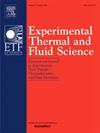壁挂式气缸前近壁面流动特性及瞬时壁面剪应力试验研究
IF 2.8
2区 工程技术
Q2 ENGINEERING, MECHANICAL
Experimental Thermal and Fluid Science
Pub Date : 2025-01-26
DOI:10.1016/j.expthermflusci.2025.111424
引用次数: 0
摘要
壁挂柱体前近壁流动特征和瞬时壁面剪应力特征对于理解桥墩局部冲刷机理和正确预测桥墩局部冲刷深度具有重要意义。本文采用高分辨率粒子跟踪测速仪(PTV)测量了垂直安装在开放通道中的圆形和方形圆柱体前的近壁流动,雷诺数为9800 ~ 16300。确定粘性亚层厚度后,得到瞬时壁剪应力。粘性亚层位于向下流动即湍流马蹄涡、角涡和沿壁面射流状逆流的下方,其时间平均流速沿壁面法向呈线性变化。在湍流马蹄形涡下方和远离马蹄形涡的区域,其厚度分别比均匀明渠流厚和薄。湍流马蹄形涡系统主导区域的瞬时壁面剪应力呈现双峰特征。时间平均壁面剪切应力被显著放大,圆形和方形圆柱体上游流动的最大放大系数分别约为2.5和4.0。两种流动中受湍流马蹄涡影响的壁面剪切应力对应的湍流强度分别约为2.0和5.5。结果表明,墙剪应力波动对正确预测桥墩等水内筒体结构的局部冲刷至关重要。但是,壁面剪应力的特征与明渠湍流有明显的不同。本文章由计算机程序翻译,如有差异,请以英文原文为准。
Experimental study on the characteristics of near-wall flow and instantaneous wall shear stress in front of wall-mounted cylinders
Characteristics of near-wall flow and instantaneous wall shear stress in front of wall-mounted cylinders are crucial for understanding the mechanism and correctly predicting the depth of local scour at piers. Here, the near-wall flow in front of circular and square cylinders mounted vertically in an open channel with Reynolds numbers from 9800 to 16,300 was measured via high-resolution particle tracking velocimetry (PTV). The instantaneous wall shear stress was obtained after determining the viscous sublayer thickness. The viscous sublayer, where the time-averaged streamwise velocity varies linearly along the wall-normal direction, is located below the downward flow, i.e., the turbulent horseshoe vortex, corner vortex, and jet-like reverse flow along the wall. Its thickness in the region below and away from the turbulent horseshoe vortices is thicker and thinner than that of uniform open channel flows, respectively. The instantaneous wall shear stress in the region dominated by the turbulent horseshoe vortex system exhibits a bimodal feature. The time-averaged wall shear stress is significantly amplified, with maximum magnification factors of approximately 2.5 and 4.0 in the flows upstream of the circular and square cylinders, respectively. Moreover, the corresponding turbulence intensities of the wall shear stress influenced by the turbulent horseshoe vortex in these two flows are approximately 2.0 and 5.5. The results indicate that the fluctuation of wall shear stress is crucial for correctly predicting the local scour at in-water cylinder structures such as bridge piers. However, the characteristics of wall shear stress are significantly different from those of turbulent open channel flows.
求助全文
通过发布文献求助,成功后即可免费获取论文全文。
去求助
来源期刊

Experimental Thermal and Fluid Science
工程技术-工程:机械
CiteScore
6.70
自引率
3.10%
发文量
159
审稿时长
34 days
期刊介绍:
Experimental Thermal and Fluid Science provides a forum for research emphasizing experimental work that enhances fundamental understanding of heat transfer, thermodynamics, and fluid mechanics. In addition to the principal areas of research, the journal covers research results in related fields, including combined heat and mass transfer, flows with phase transition, micro- and nano-scale systems, multiphase flow, combustion, radiative transfer, porous media, cryogenics, turbulence, and novel experimental techniques.
 求助内容:
求助内容: 应助结果提醒方式:
应助结果提醒方式:


